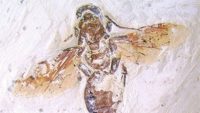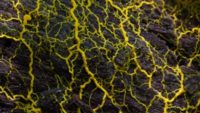Whatever the flower colour of your morning glory plant, it did not evolve that way. …read more Source: creation.com
By Dr. Jerry Bergman The history of the mutation theory as the foundation of the source of new genetic information is reviewed. …read more Source: AIG Daily
In the past 15 years, it’s been determined that a vast ocean once covered the western Amazon drainage basin.1 However, studies of the Miocene fossils reveal a conflicting story.1 Fossils are found representing both fresh water and salt water environments in the same layers, leaving evolutionary scientists befuddled. How did these fossils get mixed together? A relatively recent paper published in the Journal of Biog… More… …read more Source: icr.org
The new science about DNA that challenges evolution …read more Source: creation.com
Whether pest control experts realize it or not, successful pesticide strategies have been designed from a creationist perspective. …read more Source: creation.com
By Dr. Andrew A. Snelling Uniformitarian storytellers aim to interpret earth’s “Middle Age” while ignoring the only eyewitness to our planet’s catastrophic past: God. …read more Source: AIG Daily
Volcanism and meteorite impacts likely kick-started an immediate cooling after the global Flood …read more Source: creation.com
Using the same philosophy (uniformitarianism) employed by evolutionists, the oceans fail to live up to old-earth expectations. …read more Source: creation.com
Scientists have sequenced small amounts of DNA from the teeth of two Siberian mammoths said to have lived more than a million years ago.1,2 The discovery has set an official record for the oldest DNA ever recovered, and it also raises a number of questions relevant to the creation-evolution controversy. Can DNA survive longer than a million years? Creationists have pointed out that original proteins found in dinosaur rem… More… …read more Source: icr.org
By Dr. Dana Sneed Physics, mathematics, and constants like pi are only possible because we live in a rational universe upheld by a constant, unchanging, and consistent God. …read more Source: AIG Daily
Rapid evolution?-Are Aussie snakes really evolving to cope with toxic toads? CMI’s Dr David Catchpoole investigates. …read more Source: creation.com
One of the most famous living fossils is back in the news. The coelacanth is an endangered deep-sea fish. Its fins fit to unique, wrist-like bones, and unique bony plates envelop what scientists call its lung, which is like the swim bladder that controls buoyancy in other fishes. A new coelacanth fossil find measures more than double the size of live specimens while calling attention to outdated ideas about fossils. This fossil&rsq… More… …read more Source: icr.org
Dismantling the millions and billions of years timeframe deprives evolution of its foundation, gutting atheism of its beachhead for firing ‘doubt-missiles’. …read more Source: creation.com
By Stephen Bartholomew, Jr. In recent years evolutionists have increasingly promoted the evolution of whales as one of the most convincing examples of macroevolution. …read more Source: AIG Daily
By Dr. Gabriela Haynes The fine details preserved in fossils mystify evolutionists but not paleontologists who believe in the Genesis flood. …read more Source: AIG Daily
Warm- and cold-climate animal fossils found together conflicts with uniformitarian ice ages, but fits with the biblical Ice Age. …read more Source: creation.com
A recent study has found that the destruction of plants preceded the destruction of many forms of animal life in the rock record.1 This is exactly what was predicted in ICR’s Flood model.2 According to standard uniformitarian theory, the boundary between the Permian and Triassic Systems is supposed to be marked by the largest extinction event of all time. Evolutionary scientists claim that roughly 90% of… More… …read more Source: icr.org
The recent discovery of a tiny tyrannosaur jaw bone fragment and a claw has some scientists again pushing dinosaurs as birds.1 But is there any evidence that T. rex had feathers, as so often is portrayed, let alone as young hatchlings? A group of paleontologists, led by Gregory Funston from the University of Edinburgh, have identified the first embryonic bones from a tyrannosaur, a tiny jaw fragment and a claw. … More… …read more Source: icr.org
Have cane toads evolved since invading Australia? Certainly both toads and native fauna have changed-but it’s not evolution. …read more Source: creation.com
By Dr. Terry Mortenson Today, most people in the world, including most people in the Church, take for granted that the earth and universe are millions and millions of years old. …read more Source: AIG Daily
By Dr. Don DeYoung Food-gathering slime molds can build a complex network as efficient as Tokyo’s rail system in just 24 hours, without giving it a second thought! …read more Source: AIG Daily
By Patricia Engler “Four-million-year-old fossil offers proof of human evolution!” Here’s how to sort through such claims with biblical, critical thinking. …read more Source: AIG Daily
This huge dicynodont means evolutionary history needs revising-again! …read more Source: creation.com
Applying a data filtering method to help clarify created kinds in dinosaur and cephalopod datasets. …read more Source: creation.com
By Dr. Georgia Purdom Exploring how Adam, Methuselah, and Noah in the book of Genesis really lived for centuries and biological/genetic reasons why humans no longer live that long. …read more Source: AIG Daily
How would you do if someone spun you around every few seconds all day long? Marine algae repeatedly get tossed about in coastal surf, and they cope quite well. Researchers want to find out how. The latest set of experiments has revealed built-in machinery that helps these single-celled creatures thrive amid the turbulence. Peering into the ways those cellular systems work invokes big questions about how those systems got there in the first place…. More… …read more Source: icr.org
By Dr. Danny R. Faulkner An overview of the light travel time problem, how different biblical creationists have addressed it, and the dasha solution to the problem …read more Source: AIG Daily













































